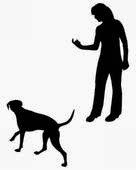Basic Manners - Level Two: Class #1
The first class is a review of all things learned in Basic Manners Level One...
3 Things on your body that are Rewarding to Dogs:
- Voice
- Eye Contact
- Touch
Anytime you engage your dog in one of these things, you are basically rewarding whatever behavior they are doing at that time. This is important to keep in mind so we do not unintentionally reward bad behaviors.
You must catch a bad behavior within 2 seconds to change the behavior.
Marker Word: “Good” or “Yes” or the clicker
This is what we say to mark the behavior we wanted. Saying this is telling the dog, “that was exactly what I was looking for!” The more you mark good behavior in a positive way, the more your dog will want to engage in good behavior.
No Reward Marker: “uh-oh” or “eh-eh”
This is to let the dog know that this is not what I was looking for you to do now. We want to mark the behavior as not what we wanted, but we want to do so in a way that will still encourage the dog to want to learn. When using an “uh-oh” while training, remember to take a step away from the dog to help “re-set” the brain, then try again. Remember to only say cues ONE TIME, then wait 30 seconds to a minute before giving your “uh-oh” (give the dog a chance to make the right decision).
Basic Manners Review:
Look/ Watch Me:
We practice this command because we want a dog who looks to us for permission and direction. Practice this cue both the simple way (directly from the dog’s nose up to your eye), and with the T position (start the same, then when the treat comes to your eye, move both arms out into a T position).
The Rules:
- Safety first. Always have a leash or be in an enclosed area.
- When you say come, you have to see it happen.
- NEVER punish a dog for coming to you.
The Steps:
- Say the dog’s name and Come, one time only.
- Have a party.
- Lure (or gently lead) the dog back to you.
When your dog pulls on the leash, you have two options…
- Stop and wait for the dog to move in a way that releases the tension of the leash.
- Say “let’s go” and go off promptly in the opposite direction.
Sit, Down, & Stand:
All these positions should already be well practiced. Dogs should know the verbal and hand signals for each command.
Leave-It:
This should mean to a dog, turn away from that, don’t pay attention to that, leave that thing alone. Remember that whatever you are asking your dog to Leave It, he should NOT get that item at the time you are practicing the Leave-It. Never practice Leave-It/ Take-It (this can teach a dog to leave something alone for a second, then take it anyway). We want our dogs to know that when I say to leave something alone, you don’t touch it ever.
Making Leave-It harder: 1. Treat in closed hand, 2. Treat in partially open hand,
3. Treat in open hand, 4. Treat in open hand on the ground, 5. Treat on the ground.
Means to your dog, stay in this position until I come back to release you. This is not the same thing as Wait. There are 3 parts to the Stay Cue:
- Duration (Time)
- Distance
- Distractions
Drop It/ Give:
When teaching this cue, we must be aware of possible Resource Guarding. Remember to NEVER steal things from your dog’s mouth. To teach Drop It/ Give:
Have the dog have a toy in his mouth that is not of super high value. Once the dog has the toy and is engaged with it, present a treat or reward of higher value than the toy, as the dog drops the toy, say “Drop.” It is very important to give the reward to the dog AT THE SAME TIME as you pick up the dropped toy. Do not let your dog get into the habit of snatching the reward then snatching the toy back up.
For Week 2 class, please bring a long-line leash or long rope for distance work. Also bring a squeaky toy that your dog loves. This will be used to help the dog focus back on you during Distraction work. As always, bring a variety of lots and lots of good treats that your dog loves.




No comments:
Post a Comment